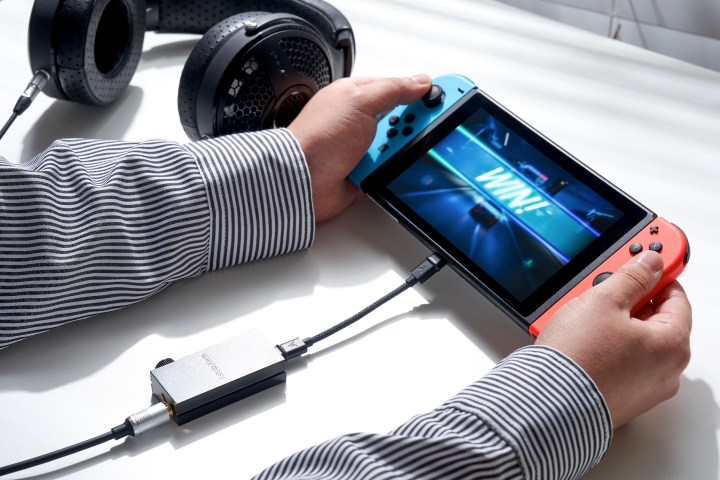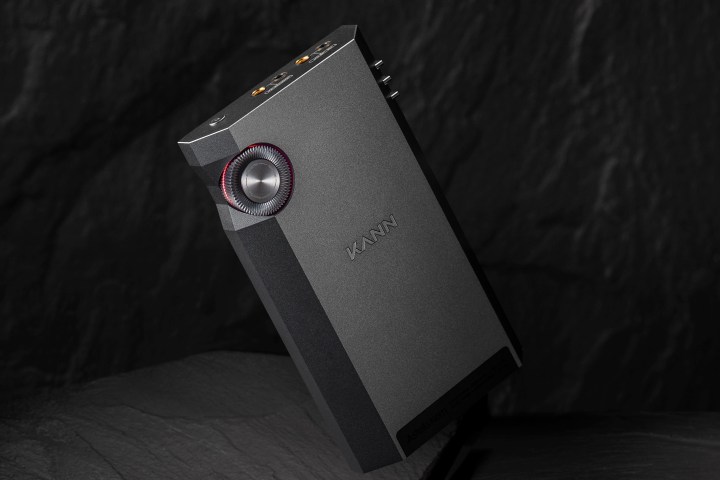
Bluetooth DAC/amp has a variety of features that will endear it to fans of hi-res audio, but if those fans are also console gamers, it could be even more attractive thanks to its support of USB Audio Class (UAC) 1.0 and its headset-friendly microphone compatibility. A&K has also announced its latest high-end portable media player, the , which offers an intriguing and versatile mix of analog outputs. Both new products will be available in November from select A&K retailers. The HB1 has been priced at $259, while the Kann Ultra will sell for $1,599.
Astell&Kern HB1 Bluetooth DAC/amp

The HB1 is absolutely bursting at the seams with features. In addition to being a standard hi-res DAC/amp for wired connections to phones, tablets, and PCs, it also supports UAC 1.0 for wired use with game consoles like the PlayStation 5 and Nintendo Switch. Despite the fact that the newer UAC 2.0 has been around for years, these gaming machines continue to rely on UAC 1.0, which few audiophile-grade DACs support.
This isn’t the first time we’ve seen a dongle-style DAC/amp promote its UAC 1.0 compatibility — the recently released budget-priced Earfun EA100 has this feature too (albeit with an awkward mode switch). However, the $80 EA100 only supports one-way audio from a UAC 1.0 console — great for better sound, but not helpful for games that require headsets. The HB1, on the other hand, supports voice audio in two ways: it has a built-in Knowles mic for folks who use in-ear monitors (IEMs) with no inline cable mic (or who use the 4.4mm balanced output), and a 3.5mm jack that uses a four-pole, mic-compatible design for headsets or wired earbuds with inline mics.
In many ways, the HB1 is similar to Fiio’s BTR7, but that Bluetooth DAC lacks UAC 1.0 support, has no built-in mic, and you need to buy a different version depending on whether you need iOS Lightning compatibility or not.

As far as its regular audio chops go, the HB1 is comprehensive: thanks to its ESS ES9281AC PRO DAC, it supports native DSD256 and up to 32-bit/384 kHz lossless audio, including up to 8x rendering of MQA tracks if you connect the HB1 to an MQA-decoding device/app like the Tidal client running on an iPhone or Android phone. Speaking of iPhone and Android, the HB1 comes with both USB-C-to-USB-C and a USB-C-to-Lightning adapter cables so you can work with virtually any device and any platform. There’s also a companion app for both iOS and Android that lets you configure several of the HB1’s settings.
It’s hard not to notice the huge dedicated volume knob on the side of the HB1. It’s been a stylistic cue of A&K’s portable devices for years. However, we’re not entirely sure if it makes sense for a Bluetooth DAC that might be shoved in a pocket or other places where that knob could be inadvertently turned. We’re also a bit surprised that the HB1 doesn’t come with a clip so you can wear it on clothing — an especially important function if you’re going to use it with the built-in mic we mentioned.

In terms of Bluetooth, you get support for Multipoint, so the the HB1 can be connected to two source devices simultaneously, and there’s built-in hi-res audio codec compatibility with LDAC and aptX HD. Strangely, there’s no aptX Adaptive compatibility, a bizarre omission given that A&K is using a Qualcomm Bluetooth chipset.
Cleverly, the HB1 can be configured to give Bluetooth priority, so if you’re connected via USB and the DAC senses a new Bluetooth session, it will switch automatically. There are also options for how the DAC recharges via USB. Speaking of that, battery life on the HB1 has been pegged at six hours if you use the 3.5mm unbalanced port or 5.5 hours if you use the 4.4mm balanced port, at 50% volume.
Astell&Kern Kann Ultra

The latest portable media player in the Kann family, the Ultra will look instantly familiar to A&K fans, with its sharply angled facets and oversized volume knob. What makes the Ultra stand out is the unusual collection of analog outputs — you get four in total: 3.5mm unbalanced and 4.4mm balanced headphone outputs and combo preamp/line-out outputs.
The headphone jacks have four gain presets and output that can go as high as 16Vrms — which should be able to drive even the highest impedance headphones effortlessly. The preamp/line-out outputs run through a dedicated preamplifier, letting you control the volume when in preamp mode or bypass the preamp completely in line-out mode, with four fixed voltage levels from 1.4V to 4V.

Why so many options? The Ultra is designed to be used with just about any analog input you can think of, from high-end IEMs and wired headphones to stereo amplifiers, active speakers, and AV receivers. The intent is for folks to run all of their digital audio sources — whether they’re streaming music services or audio files stored in the Ultra’s 128GB of onboard storage — through its top-of-the-line flagship DAC from ESS, the ESS9039MPRO, which is used in a dual-DAC configuration.
As you might guess, the ESS DAC is able to process just about any digital source, up to lossless 32-bit/768kHz and native DSD512. It’s also a full MQA decoder.

The Kann Ultra also provides features that were introduced on the A&Ultima SP3000, including:
- Digital Audio Remaster Technology (DAR), which upsamples the sample rate of the sound source being played, allowing more refined play and “analog-like original sound.”
- Crossfeed, which mixes parts of the original signal from one channel and sends that signal to the opposite channel with a time difference to center the sound image, like when listening with speakers. Settings such as shelf cutoff, shelf gain, and mixer level, let you adjust the level of crossfeed.
- DAC Filter: seven DAC filters that let you fine-tune the sound.
- ReplayGain, which maintains a consistent playback level between tracks.
Astell&Kern Kann Ultra
Astell&Kern AK HB1



